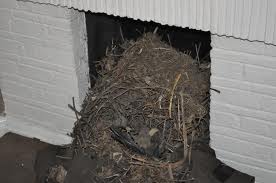 BIRDS NESTING IN
BIRDS NESTING IN
CHIMNEYS
It is that time of year again when the birds are going to start to nest in the next few weeks. Over the last three days I have received requests to fit six bird guards or caps to stop birds nesting. There is one bird in particular which likes to nest in chimneys, active or disused, solid fuel or gas, the Jackdaw. I regard the Jackdaw as some kind of avian nemesis to chimney sweeps. They just love to build nests in chimneys. So here are a few thoughts on detection and prevention:
Nest Construction.
The way they build the nest is by dropping or pushing twigs down the chimney. If the chimney is small enough they will bend the twig in the middle as they push it down the flue. When they release it, it may wedge itself in place. If not it catch further down the chimney or will fall to the bottom of the flue. Irrespective of if it sticks in place or falls another twig is added and so on. Quite often the twigs will fall to the bend in the chimney, which is common to most chimneys, which is about two thirds of the way up. As above, twigs keep being added until it is high enough to finish off. In some cases it may start at the fire grate of throat (area just above the fire). As the pile of twigs is constructed all sorts of material is added to the twig in load. Flattened cigarette packs, paper, plastic bags, take away trays and so on. As the nest reaches the top of the flue other material such as horse manure, moss, grass, hair and fur and other softer material is put in place where the eggs will be laid. This upper layer often forms a solid dung/twig/grass ball which is incredibly hard to break. Once they start nesting they are unlikely to stop. However, there are a few things you can look out for if you suspect that you have birds nesting in your chimney:
Twigs.
If you start to find twigs and other debris in your fire grate then there is a strong possibility that nesting activity is taking place.
Bird Movement.
Take a few minutes to keep a watch on your chimney pot. You will see the birds flying back and forth dropping or pushing material into the chimney pot.
Noise.
If you normally hear pigeons cooing or traffic noise and then it stops and all is silent there may be an obstruction in the flue.
What to do.
Do not try to light a fire and “burn the nest out”. You run the risk of setting the chimney on fire or filling the whole house with smoke. If it is in the early stages then get a chimney sweep in immediately you suspect nesting is taking place. If you leave it to the middle of March it will be too late as it is an offence under the Wildlife and Countryside Act to destroy or remove a nest while it is in use. You will have to wait until the end of August to remove the nest. Get the chimney swept and a proper British Standard/EU compliant bird guard fitted for your appliance. There are different type for gas, oil and solid fuel.
Nest Removal.
This is a very physical and time consuming job. All loose material at the bottom of the flue is removed. The nest is then broken up using a hard, small hard brush or a metal nest removal tool. Eventually the size of the brush is increased until the nest is completely removed. Ask the sweep to let you see the brush coming out of the pot. Also ensure that he does a smoke draw test at the end of the procedure.
Problems Associated with Nesting.
Quite often as the nesting season progresses the twigs dry out and shrink. As they do the weight from above, the mud and the chicks can cause the nest to slip down the chimney. It only has to fall a short way before the birds cannot get enough lift to fly out. They die in the chimney. A summer progresses nature and the flies do their business and quite often there is an over powering smell and or a plague of flies in the room at the bottom of the chimney. The fly infestation normally lasts about 3 – 7 days.
Summary.
Nesting season is mid March until August or when the chicks have fledged. Signs of nesting are twigs at the bottom of the chimney; a lot of activity around the pot; the chimney becomes quiet. If you suspect nesting do not try to burn it out but get a sweep in to remove it. Then immediately fit a proper bird guard. A fly infestation is often a sign of a collapsed nest or a dead bird in the chimney. For more information on bird nest removal contact Sweepover Chimney Sweep.
Sweepover removes nests and fits appropriate cowls in buff and terracotta.

Leave a Reply